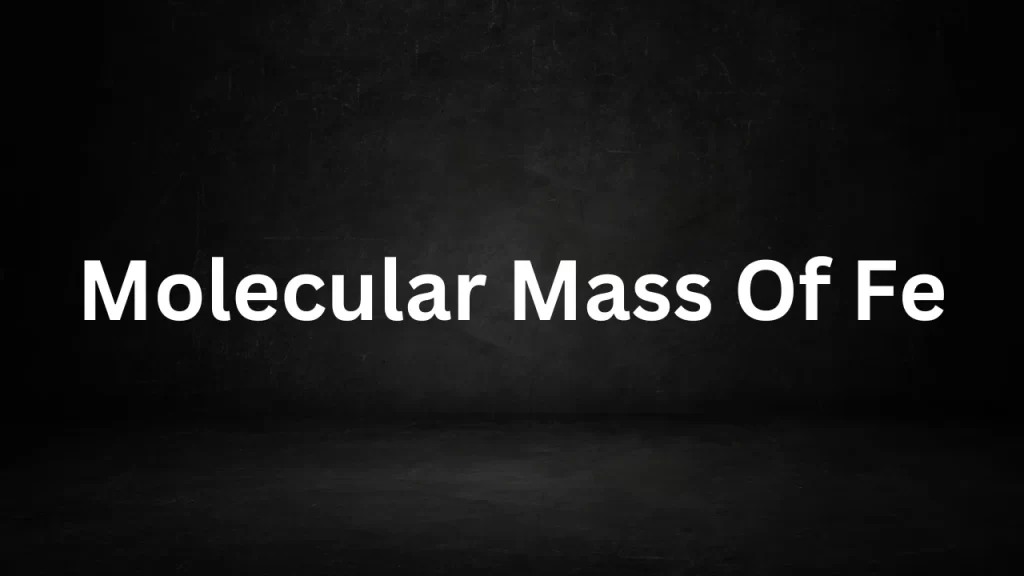Tag: ferric nitrate molecular weight
Molecular Mass Of Fe
Molecular Mass Of Fe: Molecular mass, also known as molar mass, is a fundamental concept in chemistry that helps us understand the properties and behavior of substances at the molecular level.
In this article, we delve into the molecular mass of Fe, which represents iron, one of the most abundant and essential elements on Earth. Understanding the molecular mass of iron is crucial in various scientific and industrial applications.

Molecular Mass Of Fe
Understanding Molecular Mass
Before we explore the molecular mass of Fe, it’s essential to grasp the concept itself. Molecular mass refers to the mass of a molecule, expressed in atomic mass units (amu) or unified atomic mass units (u). This quantity is ascertained by summing the atomic masses of all the atoms contained within a molecule. For iron (Fe), this calculation involves considering the atomic mass of a single iron atom.
The Composition of Iron (Fe)
Iron (Fe) is an element, and its mole mass refers to the atomic mass of a single iron atom. The atomic mass of iron is approximately 55.85 amu or 55.85 u.
Calculation of Molecular Mass of Fe
The mole mass of Fe is equal to the atomic mass of a single iron atom:
Molecular Mass of Fe = Atomic Mass of Fe Molecular Mass of Fe = 55.85 amu (or u)
Therefore, the molecular mass of Fe is approximately 55.85 atomic mass units (amu) or unified atomic mass units (u).
Significance of Iron (Fe)
Iron is a vital element with significant importance in various fields:
- Abundance: Iron is one of the most abundant elements on Earth and is found in various forms, including ores, minerals, and in the Earth’s core. It is a crucial component of our planet’s geology.
- Industrial Applications: Iron and its alloys, including steel, have extensive applications in the construction, manufacturing, and transportation sectors. Steel, renowned for its robustness and longevity, is especially recognized.
- Biological Role: Iron is essential for living organisms, playing a crucial role in hemoglobin, a protein that transports oxygen in our blood. It also participates in enzymatic reactions and various metabolic processes.
- Technological Advancements: Iron is a key element in the production of magnets, electric motors, and various electronic devices.
Applications of Molecular Mass
Understanding the mole mass of elements like iron (Fe) has several applications in chemistry and related fields:
- Stoichiometry: Molecular mass is crucial in stoichiometry, helping determine the quantities of reactants and products in chemical reactions.
- Analytical Chemistry: Molecular mass is applied in mass spectrometry, a technique used for the identification and quantification of compounds.
- Materials Science: In materials science, the molecular mass of elements and compounds influences the properties of materials, including their strength, conductivity, and reactivity.
Conclusion
The mole mass of Fe, approximately 55.85 atomic mass units (amu) or unified atomic mass units (u), reflects the atomic mass of a single iron atom. Iron is a ubiquitous and essential element with diverse applications, ranging from construction to biology and technology. Understanding the molecular mass of elements like iron is fundamental in chemistry and contributes to advancements in science, industry, and our daily lives.
Read More
- Molecular Weight Of H2
- Molar Mass Of Methane
- Molecular Mass Of Sodium Hydroxide
- Molar Mass Of Ethyl Alcohol
- Molecular Mass Of Calcium Carbonate
Frequently Asked Questions (FAQs) On Molecular Mass Of Fe
1. What is the molecular mass of Fe (iron)?
The mole mass of Fe (iron) is approximately 55.85 atomic mass units (amu) or unified atomic mass units (u). This value represents the atomic mass of a single iron atom.
2. Why is the molecular mass of iron important?
The mole mass of iron is important because it provides information about the atomic mass of a single iron atom. It constitutes a fundamental principle in the realm of chemistry and finds application in stoichiometry, analytical chemistry, and materials science.
3. How do you calculate the molecular mass of Fe?
The molecular mass of Fe is determined by taking into account the atomic mass of an individual iron atom, which is approximately 55.85 amu (or u).
4. What is the significance of iron (Fe) in various fields?
Iron is a vital element with significance in geology, industry, biology, and technology. It is abundant in the Earth’s crust, widely used in construction and manufacturing, essential for living organisms (especially in hemoglobin), and plays a role in technological advancements.
5. What are the applications of the molecular mass of Fe (iron) in the field of chemistry?
The mole mass of Fe is utilized in stoichiometry to ascertain the quantities of reactants and products in chemical reactions. Furthermore, it finds application in analytical chemistry, notably in mass spectrometry.